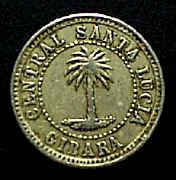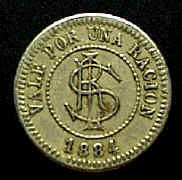

CENTRAL "SANTA LUCIA"
Gibara, Oriente, Cuba


The 'Central' |The Lands of the Mill | The Mill | TheRailroad | The Port | ThePeculiarity of the Mill
This sugar mill is,without a doubt, one of the oldest Cuban properties. Its founder, Don Rafael Lucas Sánchez Hill, established it around 1857,or about the middle of the past century. As such it has been in existence threequarters of a century.
Don Rafael Lucas Sánchez was a man of stout and old Cuban lineage (1), wellconnected and exceptionally gifted for business. Even though until then the cityof Matanzas had been the family cradle and the center of its activities, thelands in Oriente, though still virgin, attracted him as a fascinating promisefor the future, and it was there that he moved to in search of what later wouldrepresent the promised land of the great sugar centers of Cuba.
The mill was not initially named “Santa Lucía”. Its first name was Guabajaney, after the river that flowed through its fertile lands.
A rudimentary “common train”, as it was then known
the milling process and sometimes referred to as a “smoking pipe” (cachimbo),
produced only a few hundred barrels of raw sugar (mascabado), was all that
constituted the primitive “Guabajaney”.
[top]
The irrevocable perseverance in his work, encouraged by a praise worthy and natural ambition to prosper, and the unrelenting effort of the founder’s sons transformed that “smoking pipe” (cachimbo), years later, into a sugarmill, which became a real emporium of wealth.
In writing the history of the Central Santa Lucía, one cannot omit the special conditions that distinguished it from the other sugar mills at the time - conditions that refer to its origin, development and organization.
Its founding was the result of
one individual, not as it generally happens when there are various associated
groups and capital investments. For its development it only had the exclusive
involvement and cooperation of the family and heirs of Don Rafael Lucas Sánchez,
and it maintained, throughout the years, the original organization, which can be
summed up in the efforts of threegenerations of Cubans.
Needless to say that this property, held by one of the oldest Cuban families survived great crisis that disturbed the principal national industry, thanks to its own organization because there was no lessening of the sacrifices made in any way.
Our wars of independence were for
the Santa Lucía mill very difficult times, to the point that, on more than one
occasion its owners thought that their efforts and sacrifices would disappear.
Cuba’s independence and its following prosperity secured, at last, the quality
of life, progress and stability of that valuable effort.
[top]
The lands that comprised the rudimentary mill “Guabajaney”, were not one third of the actual extension. Successive acquisitions, many of them very costly, tripled the lands of the Santa Lucía.
Today the lands that comprise the property are approximately 3,200 “caballerias”(107,200 acres) - 1,155 “caballerias” (38,600 acres) cultivated for sugar cane divided into 4 zones. Approximately 300 “caballerias” (10,050 acres) for cattle ranching and the rest mountains and grassy plains.
The milling plant of the Santa Lucía followed the same transformations that modern industry experienced in the field of mechanics. Between the rudimentary “common train” installed in 1857 and the present milling plant, it is incredible that both were destined to the same end and worked on the same principle. That common train was replaced in 1881 with mortars and grinders that had just recently been invented, and these in turn were replaced in 1911 with tandems, also of recent invention. Even so, the constant improvement in machinery for sugar mills continued to perfect the milling system used there.
The milling plant is composed of two sets of
machineries or tandems, the “Pratts” and “Farrell”, with a milling capacity to
produce 350,000 bags of sugar of 13.5“ arrobas” each (25 pounds per arroba or
8,750,000 of sugar). The first tandem of 7 ft. long mortars, a preshredder, a
shredder with four “Pratts” grinders. The second set of machinery consisted of 7
ft. long mortars, a “Fulton” shredder with three “Farrell” grinders.
[top]
The mill’s railroad system had 160 kilometers of 30 inch tracks. The railroad equipment comprised of 12 locomotives, nine large and three small, 549 cars for cane, 48 booths for sugar and supplies, 14 tank cars for molasses and petroleum and six passenger cars.
One of the lines connected the plant with the Gibara–Holguin railroad line at the Iberia station, about 27 kilometers from Santa Lucía.
The Port
The lands belonging to the Santa Lucía extended, for a long stretch, along the Northcoast of the Oriente province in the vicinity of Gibara.
The principal ports which had ample room and were well protected were Puerto Naranjo,Vita, Bariay, Juruju and the bay of Sama, with sufficient depth for large ships. This geographic combination was extremely favorable, allowing the Santa Lucia to ship directly from the mill using its own lines.
Of these ports, Vita is the one used by the company, being it, as a sub-port of Gibara, the only one officially designated for coastal trading and for general importand export.
The bay of Vita is deep and well protected, with depths of 19 ½ feet at its mouth and 25 feet at the dock, where up to four ships can be berthed at the same time.
At the port, the company has a tank for petroleum
with a capacity of one million gallons and two tanks for molasses with a
capacity of 850,000 gallons. The unloading of thepetroleum is done directly from
the ships using pumps and the loading of molasses by gravity.
In addition,
the company has in the vicinity a warehouse with a capacity to storeup to 75,000
bags of sugar, which is sufficient for the mill’s needs since itcan also ship
directly from the packing plant.
The port of Vita is approximately 1,100 miles from
New York, which is a shorter distance than from the port of Havana.
[top]
The Central Santa Lucía employs an original system for the settlement and payment of thecane to the farmers (colonos), which was established since the mill was founded.
This system, which is unique in Cuba, uses the proportional value of the sugar that will be derived from the cane using tables that were studied and calculated by mutual agreement between the owners and the farmers. Using this system the mill pays in proportion to the amount of sugar the cane will produce, which forces the farmers to better cultivate their land as the means of producing a higher economic yield of their production.
On the other hand, a characteristic of this mill, and old custom, the harvest is realized over a longer period of time, which is usually an average of ten months, making the use of the proportional value system the most adequate and fair for the settlement of the cane, since during certain periods of the harvest the yield of sugar is higher than in others having a fluctuation in the value ofthe same.
Before closing this brief history and description of the Central Santa Lucía, it is imperative that the names of Don Rafael Lucas Sánchez Hill’s sons be mentioned, since they dedicated the better part of their life to the development and improvement of the work started and bequeathed to them by their ancestor. They were Don Rafael Eusebio Sánchez y Sánchez and Don Alberto and Don Federico Sánchez y Junco.
|
|
Resources:
El
LIBRO DE CUBA, La Habana, Cuba, 15 February 1925
Footnotes:
(1) Don Rafael Lucas Sánchez Hill was born on October
24, 1808 in St. Augustine, Florida and died on May 13, 1878 in Havana, Cuba. A
plaque by the front door designates former residencce as a national historical
site on St. George St. #105 in St. Augustine, Fl.
Updated: 08/11/2013